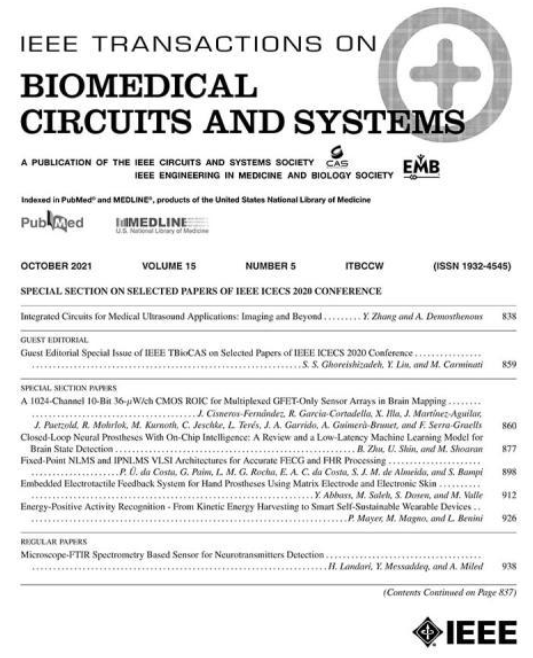Wireless Multichannel Neural Recording With a 128-Mbps UWB Transmitter for an Implantable Brain-Machine Interfaces
IF 4.9
2区 医学
Q2 ENGINEERING, BIOMEDICAL
IEEE Transactions on Biomedical Circuits and Systems
Pub Date : 2016-02-26
DOI:10.1109/TBCAS.2016.2514522
引用次数: 68
Abstract
Simultaneous recordings of neural activity at large scale, in the long term and under bio-safety conditions, can provide essential data. These data can be used to advance the technology for brain-machine interfaces in clinical applications, and to understand brain function. For this purpose, we present a new multichannel neural recording system that can record up to 4096-channel (ch) electrocorticogram data by multiple connections of customized application-specific integrated circuits (ASICs). The ASIC includes 64-ch low-noise amplifiers, analog time-division multiplexers, and 12-bit successive approximation register ADCs. Recorded data sampled at a rate of 1 kS/s are multiplexed with time division via an integrated multiplex board, and in total 51.2 Mbps of raw data for 4096 ch are generated. This system has an ultra-wideband (UWB) wireless unit for transmitting the recorded neural signals. The ASICs, multiplex boards, and UWB transmitter unit are designed with the aim of implanting them. From preliminary experiments with a human body-equivalent liquid phantom, we confirmed 4096-ch UWB wireless data transmission at 128 Mbps for distances below 20 mm .无线多通道神经记录与128-Mbps超宽带发射机为植入式脑机接口
在长期和生物安全条件下,大规模同时记录神经活动可以提供必要的数据。这些数据可以用于推进临床应用中的脑机接口技术,并了解脑功能。为此,我们提出了一种新的多通道神经记录系统,该系统可以通过定制的专用集成电路(asic)的多个连接记录多达4096通道(ch)的皮质电图数据。ASIC包括64-ch低噪声放大器、模拟时分多路复用器和12位连续逼近寄存器adc。以1ks /s的速率采样的记录数据通过集成多路复用板进行时分复用,生成4096ch的51.2 Mbps的原始数据。该系统具有一个超宽带(UWB)无线单元,用于传输所记录的神经信号。设计了asic、多路复用板和UWB发射单元,目的是植入它们。通过与人体等效的液体幻影的初步实验,我们证实了4096-ch UWB无线数据传输速度为128 Mbps,距离小于20 mm。
本文章由计算机程序翻译,如有差异,请以英文原文为准。
求助全文
约1分钟内获得全文
求助全文
来源期刊

IEEE Transactions on Biomedical Circuits and Systems
工程技术-工程:电子与电气
CiteScore
10.00
自引率
13.70%
发文量
174
审稿时长
3 months
期刊介绍:
The IEEE Transactions on Biomedical Circuits and Systems addresses areas at the crossroads of Circuits and Systems and Life Sciences. The main emphasis is on microelectronic issues in a wide range of applications found in life sciences, physical sciences and engineering. The primary goal of the journal is to bridge the unique scientific and technical activities of the Circuits and Systems Society to a wide variety of related areas such as: • Bioelectronics • Implantable and wearable electronics like cochlear and retinal prosthesis, motor control, etc. • Biotechnology sensor circuits, integrated systems, and networks • Micropower imaging technology • BioMEMS • Lab-on-chip Bio-nanotechnology • Organic Semiconductors • Biomedical Engineering • Genomics and Proteomics • Neuromorphic Engineering • Smart sensors • Low power micro- and nanoelectronics • Mixed-mode system-on-chip • Wireless technology • Gene circuits and molecular circuits • System biology • Brain science and engineering: such as neuro-informatics, neural prosthesis, cognitive engineering, brain computer interface • Healthcare: information technology for biomedical, epidemiology, and other related life science applications. General, theoretical, and application-oriented papers in the abovementioned technical areas with a Circuits and Systems perspective are encouraged to publish in TBioCAS. Of special interest are biomedical-oriented papers with a Circuits and Systems angle.
 求助内容:
求助内容: 应助结果提醒方式:
应助结果提醒方式:


